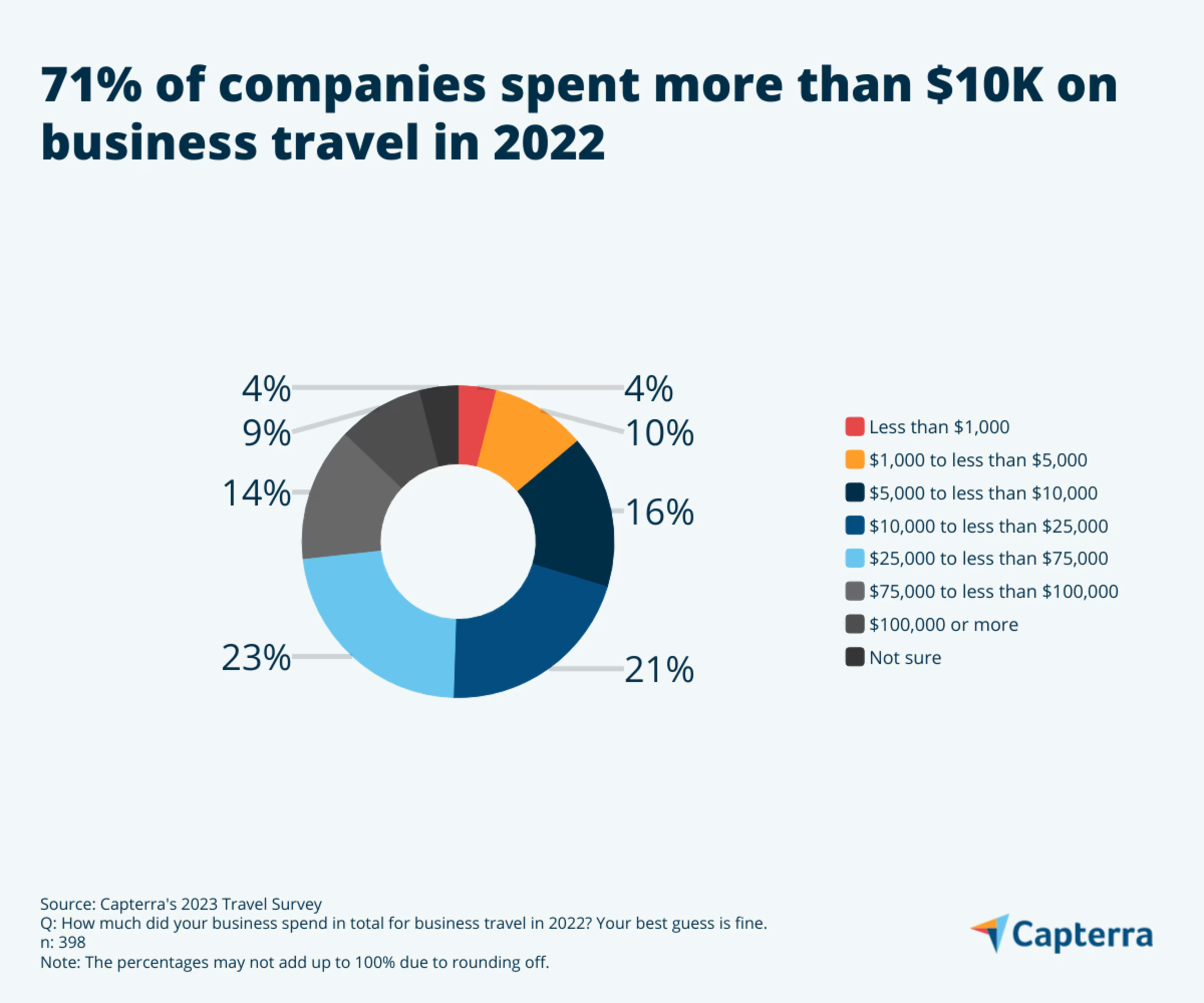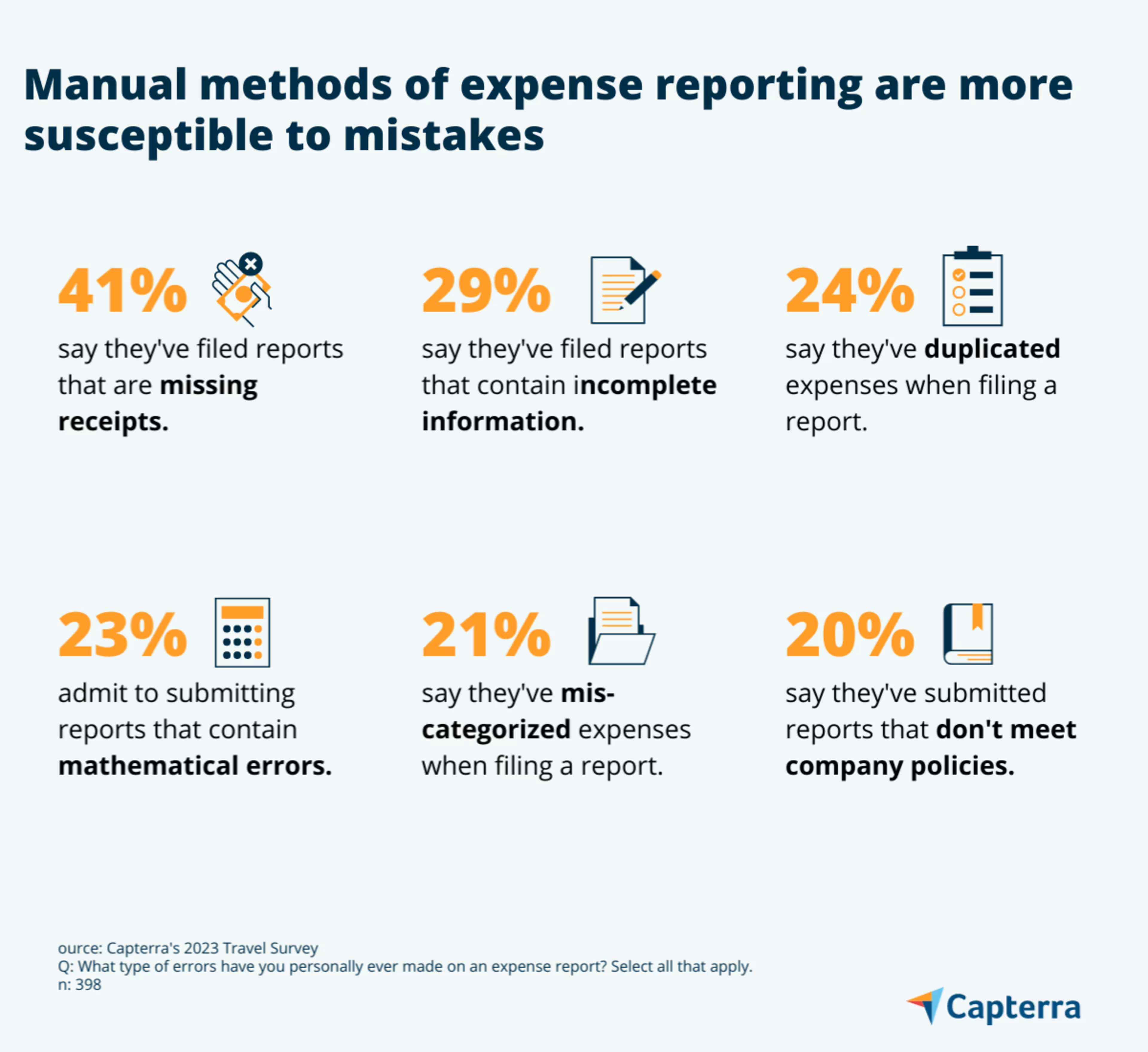92% of business travelers say tracking expenses is a challenge—here's how tech can clear the skies.
Despite shaky economic conditions and pressure within organizations to cut down on travel costs, business travel is making a comeback.
A recent Capterra survey found that 46% of business travelers report going on more trips compared to before the pandemic and that a majority of employees are adding on personal vacation time to trips.* However, more than half of travelers feel that travel is only getting more expensive, underlining the need for companies to revamp their travel and expense policies or risk burning cash due to outdated or inefficient processes.
Though many businesses have started to leverage technology to optimize these processes, an alarming number are still bound to manual methods. Your business might be hesitant to spend the time and resources to overhaul these systems, but technology can play a crucial part in helping your employees minimize costly mistakes while allowing you to ensure every travel dollar is well spent.
/ Key findings
46% of business travelers say they’re going on more trips compared to before the pandemic, even as the cost of travel rises.
85% say the economy has impacted their company’s travel spending, forcing them to set tighter budgets, explore more cost-effective options, and reduce spending on travel overall.
47% say their company still relies on spreadsheets to handle recording and reporting expense reports, and 42% of respondents share that they tackle this process by manually tracking receipts.
92% say they encounter challenges associated with expense reporting and 90% admit to making mistakes when handling the process.
93% say they engage in bleisure travel, which is when employees add personal vacation time to corporate trips, motivated by the ability to foster work-life balance, travel cost-savings, and stress relief.
Corporate travel resurges, but so do travel prices
Though the U.S. Travel Association predicts that domestic leisure travel should return to pre-pandemic levels by 2024, domestic corporate travel isn’t set to fully recover until 2025.[1]
Nevertheless, compared to before the pandemic, 46% of surveyed business travelers say they're going on more trips—on average, they travel six times a year, with trips lasting about three days. As more and more employees travel for business, many have taken to adding bleisure travel to their trips—in fact, 93% share that they’ve added personal vacation time to a corporate trip within the last year.
However, compared to pre-pandemic times, the cost of travel has increased by approximately 14%.[2] Our survey respondents confirm this—65% of business travelers say that they feel travel costs have risen within the past year. Employees say that, on average, they individually cost their business $5,000 in travel expenses in the past year.

Fuel costs, seasonal demands, and economic conditions make travel prices subject to volatile change. In light of the current economy, 85% of business travelers say that their company has taken measures to reduce costs in 2023. Beyond cutting back on overall travel spend and setting tighter budgets, some high-level strategies companies have used to adjust to rising travel costs include enacting spending limits. Notably, only 14% turned to technology to plan and report expenses.
/ Analyst's tip
Business travel yields dividends when it comes to improving business performance, but don’t forget that allowing your employees to bundle in bleisure time is also an organizational win. Employees are motivated to add personal vacation time to their trips to foster work-life balance, relieve stress, and save money. Offering the flexibility of bleisure travel is an attractive hiring perk and demonstrates that you care about their work-life balance and well-being, which can snowball into higher job satisfaction and increased retention.
Manual methods expose companies to costly errors and tedious time-sinks
Technology is being embraced by companies to assist in expense reporting—more than half of travelers say they use mobile apps or expense management software to record and report expenses.
However, 47% of companies rely on spreadsheets to handle these tasks, and an alarming 42% of businesses still manage these processes by manually tracking receipts.

Manual methods can exacerbate challenges that business travelers face when filing expenses. Organizing and tracking receipts, filling out time-consuming paperwork, and navigating complex tax regulations frustrate employees the most. Furthermore, 18% say that they struggle with understanding and following their company’s expense policies.
Employes say that many of the common errors they’ve made when filing expense reports include missing receipts, submitting documents with incomplete information, and mathematical errors—missteps that are more likely to occur with manual methods. Even in the likelihood that travelers pass on pristine reports, finance teams can run the risk of making errors when transferring information.

Keeping paper records of receipts or spending hours programming and editing formulas in spreadsheets is a waste of valuable time for your employees. As businesses scale, these manual methods become less effective and more error-prone as the volume of expenses and the complexity of travel increases.
While it’s easy to write off the consequences of making a few mistakes, businesses should know that the consequences can be costly. Poor and inefficient expense reporting processes can lead to inaccuracies in financial reporting, which can then potentially impact decision-making related to spending and budgeting forecasting. Moreover, 20% of employees admit to submitting reports that don’t align with company policies, putting businesses in a position to miss out on significant savings via tax deductions. Failing to maintain airtight expense practices also puts businesses at risk of regulatory non-compliance, which exposes them to tax penalties and potential outside audits in the future.
Business travel won’t be taking a vacation anytime soon—here’s how you can cut costs and maximize your travel processes
Given the current economy and increasing travel costs, finding ways for your business to optimize your travel processes and policies is more important than ever. To get you started on the right path, here are three recommendations that can help you save money and valuable time, all while ensuring that you and your employees get the most out of every business trip.
Forge travel partnerships for discounts and deals
Work with specific travel providers: More than half of travelers share that their company has a preferred airline or hotel for business travel. Working with a provider that offers flexible booking policies gives you and your employees more freedom to modify or cancel arrangements without incurring significant fees, and negotiating for cheaper rates with a provider based on the volume your business can generate for them is a great way to reduce overall costs.
Open corporate travel credit cards: Setting your employees up with corporate-travel credit cards is another way you can offset future costs, as many generate cashback, miles, or other points that can yield perks like free flights, room upgrades, and more.
Review, revamp, and re-communicate your travel policies
Adjust your travel policies to curb costs: Regularly reviewing your travel policies helps you identify potential areas for cost savings and ensures that you’re aligned with regulatory best practices. For instance, you can switch to providing travelers with a fixed daily stipend during trips, and since you’ll know the exact amount an employee will spend per day, you can control costs and simplify the budgeting process in one fell swoop.
Implement flexible time-off: Switching to flexible time-off policies allows your employees to make the most out of bleisure travel and also showcases that you care about work-life balance.
Clearly communicate changes: After you make any formal adjustments, be sure to share these changes with your employees and don’t forget to emphasize the proper protocol for recording and reporting expenses. Quarterly refreshers on policy and best practices can also be the best time to align on any glaring reporting challenges and to ideate on ways to eliminate common mistakes.
Calculate the cost and consequences of your business’ reporting methods
Reevaluate your reporting methods: An overwhelming number of corporate travelers (92%) say they encounter challenges with expense reporting, and a strikingly similar number (90%) admit to making mistakes when handling the process. If your business still relies on manual methods, it’s time to explore the benefits of software, which can help your business cut down on travel costs while minimizing the common errors.
Leverage the capabilities of software: Unlike manual methods, expense management and mobile app reporting software can enable businesses to do everything from creating policy checks within their systems to verifying that employees are using approved vendors to qualify for discounts or benefits. Mobile apps can make physically keeping track of receipts a thing of the past, as they empower your employees to take a photo of receipts, which are recorded and uploaded to databases in a matter of minutes. In their more advanced forms, some expense software harnesses the power of artificial intelligence (AI) and machine learning (ML) to fully automate things like expense approvals and more.
Times are changing—don’t let outdated practices keep you from soaring off into the sunset
In a post-pandemic world, business travel is resurging and it benefits both you and your employees to find new solutions to make recording and reporting expenses easier. Travelers also want to get more out of their trips, and the rise of bleisure travel means they have an opportunity to decompress and explore destinations after taking care of business initiatives. You can encourage and enhance this opportunity by thoughtfully tweaking travel strategies and accommodations.
As 2023 presses on, budgeting and planning ahead for the next fiscal year are perfect ways to ensure that, whatever is on the horizon, your business can soar off into the future with confidence.

